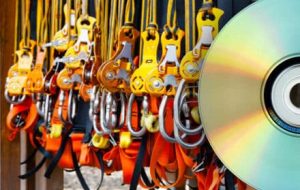Logging Operations
Home More Training Resources OSHA General Industry Training Requirements Logging Operations
OSHA Training Requirements - Logging Operations
This website is not the official or final authority to determine OSHA compliance responsibilities, which are set forth in OSHA standards themselves, and the Occupational Safety and Health Act of 1970. Because OSHA regulations are constantly being added, deleted, and/or revised, you must not rely on this website as the official or final authority of OSHA training requirements; refer to the official OSHA regulations available on OSHA’s website (osha.gov). – See disclaimers.
1910.266 – Logging Operations
(d)(4) – “Fire extinguishers.” The employer shall provide and maintain portable fire extinguishers on each machine and vehicle in accordance with the requirements of subpart L of Part 1910.
(g)(3) – The employer shall assure that operating and maintenance instructions are available in each vehicle. Each vehicle operator and maintenance employee shall comply with the operating and maintenance instructions.
(g)(4) – The employer shall assure that each vehicle operator has a valid operator’s license for the class of vehicle being operated.
(i) – “Training.”
(1) – The employer shall provide training for each employee, including supervisors, at no cost to the employee.
(2) – “Frequency.” Training shall be provided as follows:
(i) As soon as possible but not later than the effective date of this section for initial training for each current and new employee;
(ii) Prior to initial assignment for each new employee;
(iii) Whenever the employee is assigned new work tasks, tools, equipment, machines or vehicles; and
(iv) Whenever an employee demonstrates unsafe job performance.
(3) – “Content.” At a minimum, training shall consist of the following elements:
(i) Safe performance of assigned work tasks;
(ii) Safe use, operation and maintenance of tools, machines and vehicles the employee uses or operates, including emphasis on understanding and following the manufacturer’s operating and maintenance instructions, warnings and precautions;
(iii) Recognition of safety and health hazards associated with the employee’s specific work tasks, including the use of measures and work practices to prevent or control those hazards;
(iv) Recognition, prevention and control of other safety and health hazards in the logging industry;
(v) Procedures, practices and requirements of the employer’s work site; and
(vi) The requirements of this standard.
(4) – Training of an employee due to unsafe job performance, or assignment of new work tasks, tools, equipment, machines, or vehicles; may be limited to those elements in paragraph (i)(3) of this section which are relevant to the circumstances giving rise to the need for training.
(5) – “Portability of training.”
(i) Each current employee who has received training in the particular elements specified in paragraph (i)(3) of this section shall not be required to be retrained in those elements.
(ii) Each new employee who has received training in the particular elements specified in paragraph (i)(3) of this section shall not be required to be retrained in those elements prior to initial assignment.
(iii) The employer shall train each current and new employee in those elements for which the employee has not received training.
(iv) The employer is responsible for ensuring that each current and new employee can properly and safely perform the work tasks and operate the tools, equipment, machines, and vehicles used in their job.
(6) – Each new employee and each employee who is required to be trained as specified in paragraph (i)(2) of this section, shall work under the close supervision of a designated person until the employee demonstrates to the employer the ability to safely perform their new duties independently.
(7) – “First-aid training.”
(i) The employer shall assure that each employee, including supervisors, receives or has received first-aid and CPR training meeting at least the requirements specified in Appendix B.
(ii) The employer shall assure that each employee’s first-aid and CPR training and/or certificate of training remain current.
(8) – All training shall be conducted by a designated person.
(9) – The employer shall assure that all training required by this section is presented in a manner that the employee is able to understand. The employer shall assure that all training materials used are appropriate in content and vocabulary to the educational level, literacy, and language skills of the employees being trained.
(10) – “Certification of training.”
(i) The employer shall verify compliance with paragraph (i) of this section by preparing a written certification record. The written certification record shall contain the name or other identity of the employee trained, the date(s) of the training, and the signature of the person who conducted the training or the signature of the employer. If the employer relies on training conducted prior to the employee’s hiring or completed prior to the effective date of this section, the certification record shall indicate the date the employer determined the prior training was adequate.
(ii) The most recent training certification shall be maintained.
(11) – “Safety and health meetings.” The employer shall hold safety and health meetings as necessary and at least each month for each employee. Safety and health meetings may be conducted individually, in crew meetings, in larger groups, or as part of other staff meetings.
APPENDIX B – First aid and CPR Training (mandatory)
The following is deemed to be the minimal acceptable first-aid and CPR training program for employees engaged in logging activities.
First-aid and CPR training shall be conducted using the conventional methods of training such as lecture, demonstration, practical exercise and examination (both written and practical). The length of training must be sufficient to assure that trainees understand the concepts of first aid and can demonstrate their ability to perform the various procedures contained in the outline below.
At a minimum, first-aid and CPR training shall consist of the following:
1. The definition of first aid.
2. Legal issues of applying first aid (Good Samaritan Laws).
3. Basic anatomy.
4. Patient assessment and first aid for the following:
a. Respiratory arrest.
b. Cardiac arrest.
c. Hemorrhage.
d. Lacerations/abrasions.
e. Amputations.
f. Musculoskeletal injuries.
g. Shock.
h. Eye injuries.
i. Burns.
j. Loss of consciousness.
k. Extreme temperature exposure (hypothermia/hyperthermia)
l. Paralysis
m. Poisoning.
n. Loss of mental functioning (psychosis/hallucinations, etc.).
o. Drug overdose.
5. Artificial ventilation.
6. CPR.
7. Application of dressings and slings.
8. Treatment of strains, sprains, and fractures.
9. Immobilization of injured persons.
10. Handling and transporting injured persons.
11. Treatment of bites, stings, or contact with poisonous plants or animals.

On Site OSHA Training Classes

Online OSHA Training Courses

